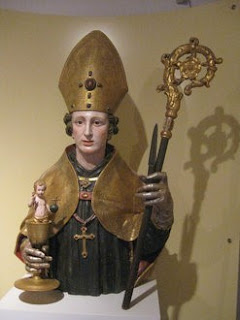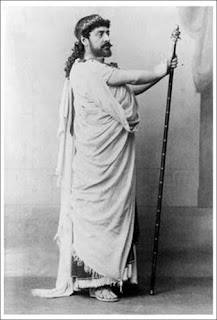10. Alto of Altomunster (Feb 9)
Alto was an Irish monk who ended up in Bavaria somehow during the 8th Century. There, he founded an abbey, called … Altomunster. Since “munster” means “monastery,” “Alto of Altomunster” basically means “Alto from Alto’s monastery.” Which sounds a tad circular, if you ask me …
Be sure to check out what’s in the cup
9. Scholastica (Feb 10)
Representation: nun with dove flying from her mouth
Patron saint of magician’s assistants?
St. Scholastica was actually the twin sister of St. Benedict, the famous monk (and author of the Benedictine Rule). She was herself a nun, and led a community of women. The two would traditionally meet once a year.
Their relationship actually explains Scholastica’s rather interesting representation as well. Turns out Benedict, at the moment of Scholastica’s death, had a vision of a dove leaving his sister’s body.
There is a St. Scholastica College, by the way – up in beautiful Duluth, Minnesota.
The Saints I get. The dog, not so much.
8. Polyeuctus of Melitene (Feb 13)
Not to be confused with Melieuctus of Polytene …
Polyeuctus was a rich Roman army officer who converted to Christianity in the 3rd Century. Not the shy and retiring type, he subsequently:
went to the city square, and tore up the edict of Decius which required everyone to worship idols. A few moments later, he met a procession carrying twelve idols through the streets of the city. He dashed the idols to the ground and trampled them underfoot. (Wikipedia)
Unsurprisingly, he was later tortured and beheaded. All of this happened in Melitene, a city in Armenia.
Somehow or other, Polyeuctus became the inspiration for a play by Corneille, an opera by Gounod, another by Donizetti, and an overture by Paul Dukas.
A dramatic presentation
7. Teilo of Llandaff ( Feb 9)
Representation: man riding a deer
Yeehah! Ride ‘em, deerboy!
Teilo was a saint of many names. In addition to Teilo, I’ve also go him down for Teliarus, Teliavus, Teliau, Telo, Theleau, Teilan, Teilio, Teilou, Teilus, Teio, Teiou, Teliou, Thelian, Theliau, Dillo, Dillon, Dol, Elidius, Elios, Eliud, Eliau, and Eillieau.
He seems to have come from quite the religious family, with a father, nephews, and a cousin all being saints as well. Teilo was a monk, bishop, and founder (of churches and monasteries), operating in Wales during the 6th Century.
The deer? In one of the many legends that surround Teilo, we learn that:
When a local lord offered him all the land he could encircle between sunset and sunrise, Teilo chose to ride on a stag to cover as much ground as possible in the time available.
6. Elfleda of Whitby (Feb 8)
She was certainly no Teilo, but I do have Elfleda also down as Edifleda, Elfeda, Ethelfieda, Edilfreda, Ethelfreda, Ethelfleda, Elgiva, and Aelflaed.. None of these, though, can compare to what Wikipedia calls her – Ælfflæd.
And what she was was a genuine royal princess (of Northumbria, the early English kingdom). She was consecrated to God at age 1 when her father, Oswy, won a major battle. Whitby is the abbey she was eventually abbess of. We’re speaking of the year 700 or so here.
5. Cuthman (Feb 8)
A neglected super-hero?
Actually, another obscure Anglo-Saxon saint, I’m afraid. This one was a poor shepherd. He’s also called Cuthman of Steyning, from the little town where he built a church. Finally, he’s also fairly well-known for carting his poor disabled mother around in a wheelbarrow (see below).
“Cuth” actually means “famous.” So, Cuthman could theoretically don his superhero cape and tights and be better known as Famous Man!
4. Humbeline of Jully (Feb 12)
Like Scholastica, Humbeline also had a famous brother. In her case, it was St. Bernard, another very well-known monk type (and founder of the Cistercians).
Humbeline herself originally led a pretty wild life. At some point, though, she turned her back on the world, joining a convent in the French town of Jully. She would eventually become abbess. All this good stuff happened around the year 1100.
Oddly, the only result when you Google Image “humbeline of jully”
(Psst: I don’t think it’s her.)
3. Appolonia of Alexandria (Feb 9)
Patronage: dental technicians
Please tell me this has nothing to do with her martyrdom.
Unfortunately, it does. I won’t go into the gory details, but her typical representation – “with pincers” – should tell you all you need to know.
Poor Appolinia … It didn’t get much better after her death. Her relics were scattered across Europe, with different Roman churches housing her head, arms, and jaw, and other parts and pieces ending up in Antwerp, Brussels, Liege, Porto, and Cologne.
2. Austrebertha of Pavilly (Feb 10)
I’m tempted to make a joke about her younger twin sister Afterbertha, but I won’t …
7th Century France. Nun, prioress, abbess. Daughter of St. Framechildis and Count Badefrid. Visionary and miracle worker. Some crazy legend about a wolf that delivered her laundry. A surprisingly popular name among Latinas.
1. Julian the Hospitaller (Feb 12)
Patronage: clowns, circus workers, jugglers, fiddle players, murderers
I’m not sure what a hospitaller is, but it sounds like it has something to do with entertainment … and maybe the unlawful premeditated killing of one human being by another as well.
Actually, a hospitaller is exactly what it sounds like. The guy built hospitals.
In addition to the above patronages, Julian is also looking out for ferrymen, hunters, pilgrims, knights, shepherds, travelers, and childless people. In other words, he’s quite the busy guy.
Honorable Mention
- Hyacinth the Solider
- John Nutter
- Baldegundus
- Erluph of Werden
- Oncho of Clonmore
- Benignus of Todi
- Dyfnog
- Felicula of Rome
- Baptus of Magnesia
- Gobnata









No comments:
Post a Comment